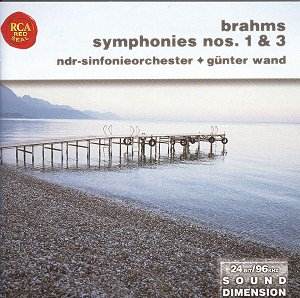This coupling of Brahms Symphonies was originally issued in the early
1980s on two separate discs. The recordings have had a varied career,
first appearing on Deutsche Harmonia Mundi and then released here on EMI.
The label was then bought up by BMG, and they were released on RCA. They
then moved from separate discs to a boxed set of three discs and finally
(to date, 2001), the current pairing at mid-price. What we have now is
a remastering of that issue to the latest 24bit/96KHz standard, and re-released
at super budget price.
Unlike the various recordings of Bruckner Symphonies
which Günter Wand has been re-recording, these discs appear
to be the only recent recordings he has made of Brahms' symphonic output.
His interpretations are up there with the best, and now that the new
re-mastering has been done, they are much better than they used to be.
The new issue has a much clearer string tone and a firmer bass line,
whereas the original discs were a little muddy in texture.
Brahms took a long time to write his first symphony
and was 43 before it saw the light of day. It caused the composer much
heartache because of his reverence for the memory of Beethoven, and
knowing that the German public saw him as the successor to his hero.
His first abortive attempt at composing a symphony resulted in the first
piano concerto and its stormy first movement has a lot in common with
the first symphony’s first movement.
It starts with a dramatic opening for full orchestra,
dominated by the timpani and then the movement proper takes over. This
is in classical form, but has a struggle of the themes in a bold and
dynamic manner. We then have a delectable slow movement, dominated at
the close by the solo violin. A light weight intermezzo follows and
then we reach the finale. Once again there is a long introduction, with
trombones to the fore. There then follows a flowing theme on the strings
which at the time of writing was said by critics to have been copied
from Beethoven’s Ninth – "Any fool can see that" was Brahms'
retort to such comments.
The symphony was a great success, and this gave Brahms
the confidence to immediately start work on his second symphony. This
was also highly successful, and after a few more short years, The third
came to fruition.
The third symphony is definitely the most autumnal
of the four, and also is the only Brahms symphony where each movement
ends quietly. By the time of writing, Brahms' reputation as a symphonist
was well established, and when the first performance took place in Vienna
on 2nd December 1883, it was well received except by the
"Wagnerites", who admittedly had lost their champion the same
year. Dvorak, one of the symphony’s early admirers wrote to his publisher
Simrock in 1883: "It is filled with a feeling which one does not
often find in Brahms. What glorious melodies there are! It is pure love,
and one’s heart could burst with joy."
This performance, typically Germanic, is strong and
forthright and also conjures up Dvorak's feeling of joy to the full.
Now that the recording quality has been significantly improved, we can
hear this interpretation in all its glory. The performance is strong
and passionate, although not quite as riveting as the Bruno Walter recording
which for me is the greatest performance of this symphony I know. A
wonderful release at a super bargain price.
John Phillips

